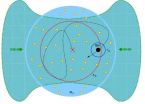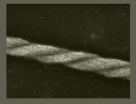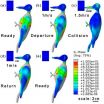(Press-News.org) At the ends of the Universe there are black holes with masses equaling billions of our sun. These giant bodies – quasars – feed on interstellar gas, swallowing large quantities of it non-stop. Thus they reveal their existence: The light that is emitted by the gas as it is sucked in and crushed by the black hole's gravity travels for eons across the Universe until it reaches our telescopes. Looking at the edges of the Universe is therefore looking into the past. These far-off, ancient quasars appear to us in their "baby photos" taken less than a billion years after the Big Bang: monstrous infants in a young Universe.
Normally, a black hole forms when a massive star, weighing tens of solar masses, explodes after its nuclear fuel is spent. Without the nuclear furnace at its core pushing against gravity, the star collapses: Much of the material is flung outwards in a great supernova blast, while the rest falls inward, forming a black hole of only about 10 solar masses.
Since these ancient quasars were first discovered, scientists have wondered what process could lead a small black hole to gorge and fatten to such an extent, so soon after the Big Bang.
In fact, several processes tend to limit how fast a black hole can grow. For example, the gas normally does not fall directly into the black hole, but gets sidetracked into a slowly spiraling flow, trickling in drop by drop. When the gas is finally swallowed by the black hole, the light it emits pushes out against the gas. That light counterbalances gravity, and it slows the flow that feeds the black hole.
So how, indeed, did these ancient quasars grow? Prof. Tal Alexander, Head of the Particle Physics and Astrophysics Department, proposes a solution in a paper written together with Prof. Priyamvada Natarajan of Yale University, which recently appeared in Science.
Their model begins with the formation of a small black hole in the very early Universe. At that time, cosmologists believe, gas streams were cold, dense and contained much larger amounts of material than the thin gas streams we see in today's cosmos. The hungry, newborn black hole moved around, changing direction all the time as it was knocked about by other baby stars in its vicinity. By quickly zigzagging, the black hole continually swept up more and more of the gas into its orbit, pulling the gas directly into it so fast, the gas could not settle into a slow, spiraling motion. The bigger the black hole got, the faster it ate; this growth rate, explains Alexander, rises faster than exponentially. After around 10 million years – a blink of an eye in cosmic time – the black hole would have filled out to around 10,000 solar masses. From then, the colossal growth rate would have slowed to a somewhat more leisurely pace, but the black hole's future path would already be set – leading it to eventually weigh in at a billion solar masses or more.
INFORMATION:
Prof. Tal Alexander's research is supported by the European Research Council.
The Weizmann Institute of Science in Rehovot, Israel, is one of the world's top-ranking multidisciplinary research institutions. Noted for its wide-ranging exploration of the natural and exact sciences, the Institute is home to scientists, students, technicians and supporting staff. Institute research efforts include the search for new ways of fighting disease and hunger, examining leading questions in mathematics and computer science, probing the physics of matter and the universe, creating novel materials and developing new strategies for protecting the environment.
Weizmann Institute news releases are posted on the World Wide Web at http://wis-wander.weizmann.ac.il, and are also available at http://www.eurekalert.org.
All-you-can-eat at the end of the universe
2014-08-11
ELSE PRESS RELEASES FROM THIS DATE:
Nanocubes get in a twist
2014-08-11
Nanocubes are anything but child's play. Weizmann Institute scientists have used them to create surprisingly yarn-like strands: They showed that given the right conditions, cube-shaped nanoparticles are able to align into winding helical structures. Their results, which reveal how nanomaterials can self-assemble into unexpectedly beautiful and complex structures, were recently published in Science.
Dr. Rafal Klajn and postdoctoral fellow Dr. Gurvinder Singh of the Institute's Organic Chemistry Department used nanocubes of an iron oxide material called magnetite. As ...
How the woodpecker avoids brain injury despite high-speed impacts via optimal anti-shock body structure
2014-08-11
Designing structures and devices that protect the body from shock and vibrations during high-velocity impacts is a universal challenge.
Scientists and engineers focusing on this challenge might make advances by studying the unique morphology of the woodpecker, whose body functions as an excellent anti-shock structure.
The woodpecker's brain can withstand repeated collisions and deceleration of 1200 g during rapid pecking. This anti-shock feature relates to the woodpecker's unique morphology and ability to absorb impact energy. Using computed tomography and the construction ...
Megascale icebergs run aground
2014-08-11
Scientists from the Alfred Wegener Institute, Helmholtz Centre for Polar and Marine Research (AWI) have found between Greenland and Spitsbergen the scours left behind on the sea bed by gigantic icebergs. The five lineaments, at a depth of 1,200 metres, are the lowest-lying iceberg scours yet to be found on the Arctic sea floor. This finding provides new understanding of the dynamics of the Ice Age and the extent of the Arctic ice sheet thousands of years ago. In addition, the researchers could draw conclusions about the export of fresh water from the Arctic into the ...
Western Wall weathering: Extreme erosion explained
2014-08-11
Visitors to the Western Wall in Jerusalem can see that some of its stones are extremely eroded. This is good news for people placing prayer notes in the wall's cracks and crevices, but presents a problem for engineers concerned about the structure's stability.
The Western Wall is a remnant of the ancient wall that surrounded the courtyard of the Jewish Temple in Jerusalem. It is located in Jerusalem's Old City at the foot of the Temple Mount.
To calculate the erosion in the different kinds of limestone that make up the Western Wall, researchers from the Hebrew University ...
Celebrity promotion of charities 'is largely ineffective,' says research
2014-08-11
Celebrity promotion of charities is ineffective at raising awareness, but can make the stars more popular with the public, new research says.
According to journal articles by three UK academics, "the ability of celebrity and advocacy to reach people is limited" and celebrities are "generally ineffective" at encouraging people to care about "distant suffering".
The research, by Professor Dan Brockington, of The University of Manchester, Professor Spensor Henson, University of Sussex, and Dr Martin Scott, University of East Anglia, is published at time when many celebrities ...
A new cause of osteoarthritis identified by research on a rare disease
2014-08-11
A new mechanism of joint destruction caused by a natural material that grinds away healthy cartilage and worsens osteoarthritis has been identified in human hip joints for the first time by University of Liverpool scientists.
The scientists, with Professor Alan Boyde and colleagues from Queen Mary University of London, were studying the hip of a man with the genetic condition, alkaptonuria (AKU), This is a metabolic disease in which a substance called homogentisic acid accumulates in joint cartilage, causing changes to its physical properties.
The study revealed ...
Challenges and strategies for women pursuing STEM careers
2014-08-11
As a national push continues to recruit talented girls and young women into math and science-related careers, a new study underlines the importance of mentoring and other social support systems for women pursuing those research professions. Mary Jean Amon, a doctoral student in the University of Cincinnati's psychology program, will present her findings at the annual convention of the American Psychological Association in Washington, D.C.
Amon's study uncovered three themes that emerged as women examined the effects of gender stereotypes in STEM fields: career strategies, ...
Sensitive acid sensor controls insulin production
2014-08-11
This news release is available in German. Many human metabolic functions only run smoothly if the acid level in the body remains neutral and stable. For humans, normal blood pH values lie between 7.35 and 7.45. By way of comparison, an empty stomach is extremely acidic, with a pH value of 1.5.
The body constantly monitors this narrow pH band and quickly restores the ideal pH values in the event of any deviations. This is because many proteins cease to function properly if fluids in the body become even slightly more acidic. These proteins become unstable and alter ...
Testosterone in healthy men increases their brains' response to threat
2014-08-11
Philadelphia, PA, August 11, 2014 – Testosterone, a steroid hormone, is well known to contribute to aggressive behavior in males, but the neural circuits through which testosterone exerts these effects have not been clear.
Prior studies found that the administration of a single dose of testosterone influenced brain circuit function. Surprisingly, however, these studies were conducted exclusively in women.
Researchers, led by Dr. Justin Carré, sought to rectify this gap by conducting a study of the effects of testosterone on the brain's response to threat cues in healthy ...
Emergency gallbladder surgery: do you need it, or can you afford to wait?
2014-08-11
Rochester, Minn. — Gallstone pain is one of the most common reasons patients visit emergency rooms. Figuring out who needs emergency gallbladder removal and who can go home and schedule surgery at their convenience is sometimes a tricky question, and it isn't always answered correctly. A new Mayo Clinic study found that 1 in 5 patients who went to the emergency room with gallbladder pain and were sent home to schedule surgery returned to the ER within 30 days needing emergency gallbladder removal. The surgical complication rate rises with the time lag before surgery, the ...



